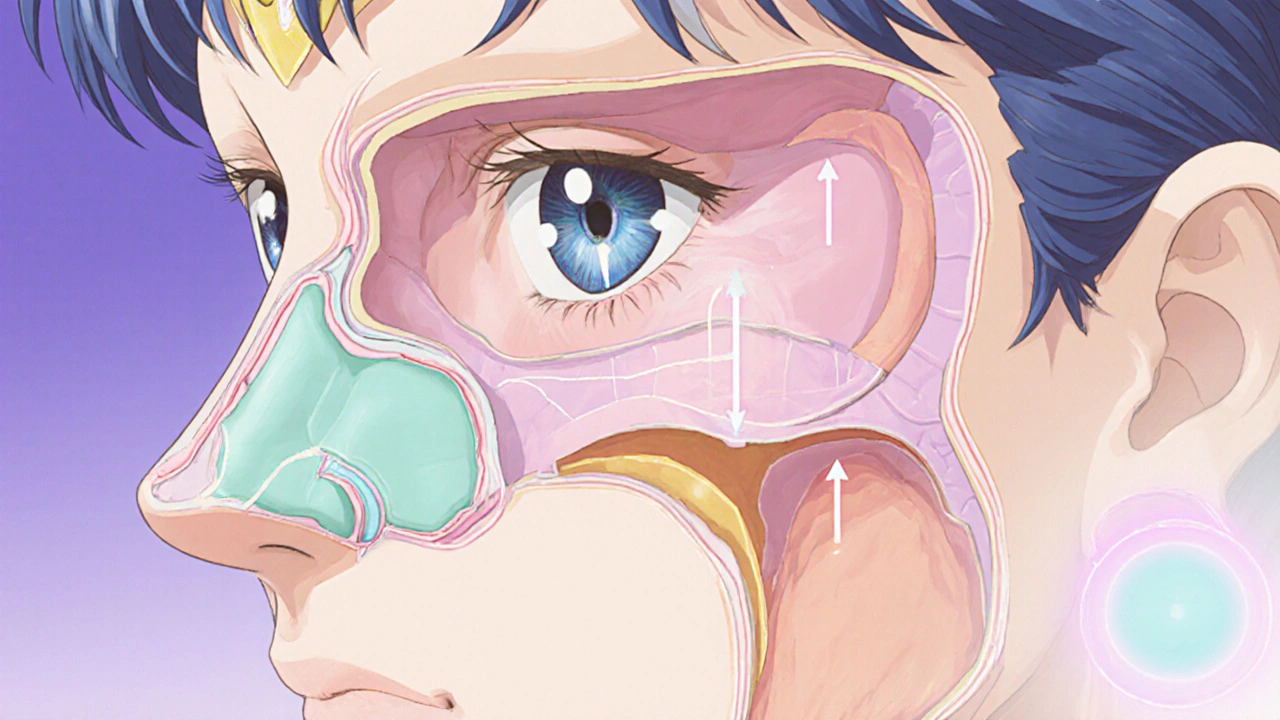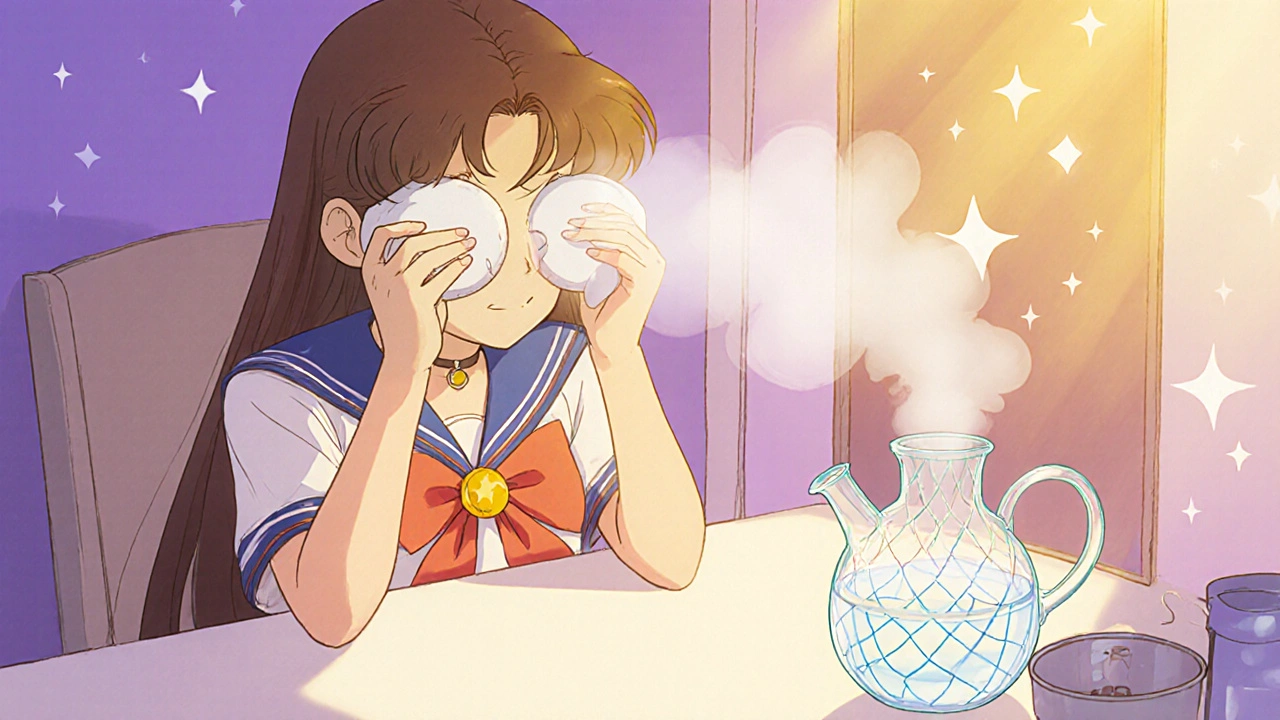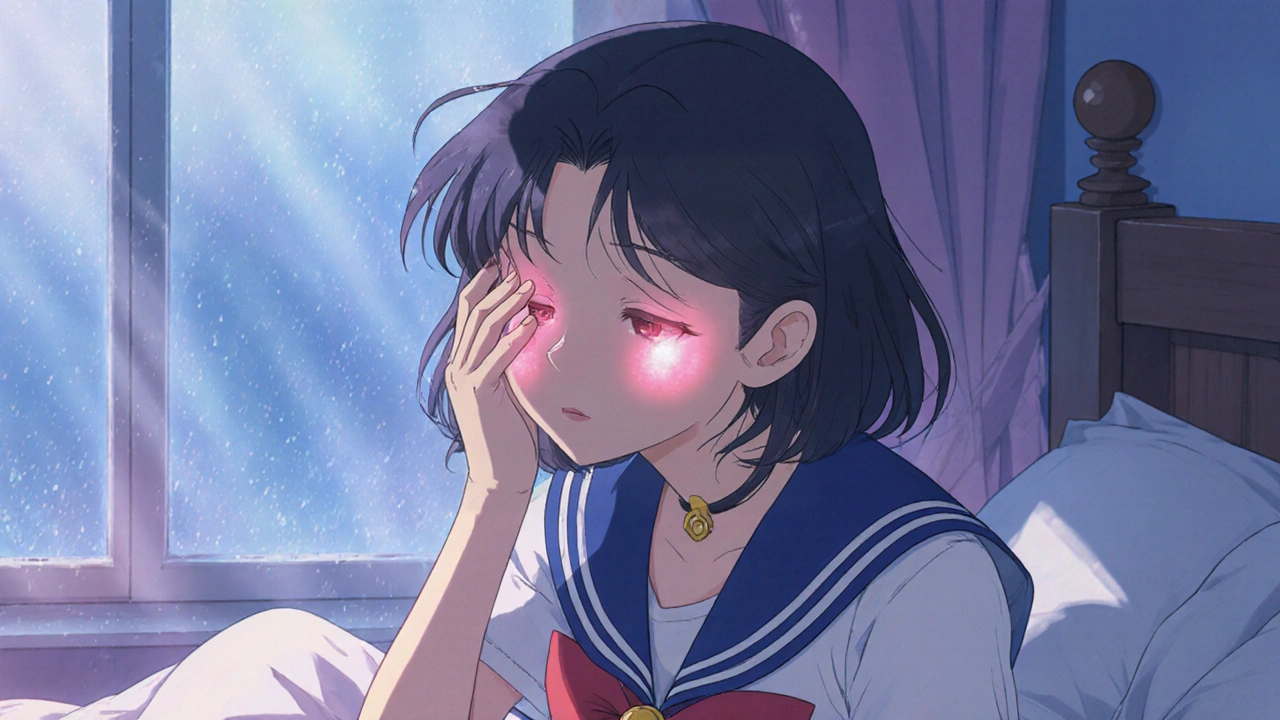Sinus-Related Eye Swelling Assessment Tool
Symptom Assessment
Answer the questions below to determine if your eye swelling is related to sinus issues. This tool is not a substitute for professional medical advice.
Quick Takeaways
- Eye swelling can be a direct result of a sinus infection when pressure builds up in the nasal passages.
- Common signs include puffiness around the eyes, pain, and a feeling of heaviness.
- If you notice fever, vision change, or severe eye pain, see a doctor right away.
- Home care (warm compress, saline rinse) often eases mild cases, but antibiotics may be needed for bacterial sinusitis.
- Keeping allergies in check and staying hydrated reduce the chance of both sinus and eye problems.
Ever woken up with a swollen eye and wondered if your recent cold had anything to do with it? You’re not alone. The link between Eye Swelling a puffiness or inflammation around the eye usually caused by fluid buildup, infection, or irritation and Sinus Infection an inflammation of the sinus lining, often due to bacteria, viruses, or allergens, that blocks normal drainage is tighter than many people realize. Below we’ll break down why the two often show up together, what to watch for, and how to treat them without over‑complicating things.
What Exactly Is Eye Swelling?
Eye swelling, medically known as periorbital edema, appears as a soft, puffy area around the eyelids or the skin under the eyes. It can be caused by:
- Allergic reactions (think pollen or pet dander)
- Infections such as conjunctivitis or orbital cellulitis
- Trauma, like a bump to the brow
- Fluid retention from sinus congestion
How Sinus Infections Develop
A sinus infection, or sinusitis, starts when the thin lining inside the nasal cavity becomes inflamed. The most common triggers are:
- Viral colds - the viruses irritate the mucous membranes, causing them to swell.
- Bacterial overgrowth - when the sinuses stay blocked, bacteria can multiply.
- Allergies - pollen or dust can cause chronic inflammation.

The Anatomical Bridge Between the Sinuses and the Eyes
The key to understanding the connection lies in the shared anatomy of the facial bones. The ethmoid sinuses sit right between the nose and the eye sockets, while the maxillary sinuses lie just below the cheekbones. When inflammation blocks the ethmoid passage, the pressure can push fluid upward into the orbital cavity.
In severe cases, bacteria can travel from the sinuses into the orbit, causing Orbital cellulitis a serious infection of the tissues surrounding the eye that can threaten vision. This is why prompt treatment of a sinus infection is crucial - it helps keep the eye safe.
Typical Symptoms When the Two Overlap
| Symptom | What It Looks Like | Common Cause |
|---|---|---|
| Puffy eyelids | Soft, swollen lids that may feel heavy | Fluid backed up from blocked sinus ostia |
| Dark circles | Gray‑purple shading under the eyes | Stagnant blood due to sinus congestion |
| Eye pain on movement | Aching sensation when looking side‑to‑side | Pressure on the orbital wall from swollen ethmoid tissue |
| Reduced vision or double vision | Blurry spots or seeing two images | Orbital cellulitis or severe inflammation |
| Runny or stuffy nose | Clear or colored discharge, nasal blockage | Underlying sinus infection itself |
Notice how many eye‑related complaints are simply a side‑effect of what’s happening deeper in the nose. When you have a sinus infection, the swelling doesn’t stay confined to the nasal passages - it can leak into the delicate tissues surrounding the eyes.
When to Seek Medical Help
Most eye swelling from a simple cold will improve with home care, but certain warning signs demand a professional’s eyes (and ears, and nose):
- Fever above 101°F (38.3°C)
- Severe pain that worsens when you move the eye
- Vision changes - blurry, dim, or double vision
- Swelling that spreads rapidly or becomes hard to the touch
- Yellow or green discharge from the eye or nose
If you notice any of these, book an appointment with an ophthalmologist a medical doctor specialized in eye health and vision care or head to urgent care. Early treatment can prevent complications like permanent vision loss.

Treatment Options: From Home Remedies to Prescription Care
How you treat eye swelling depends on the root cause.
Home Care (Mild Cases)
- Warm compress: Soak a clean cloth in warm water, wring out excess, and place over closed eyes for 5‑10 minutes, three times a day. The heat improves blood flow and helps fluid drain.
- Saline nasal rinse: Use a neti pot or squeeze bottle with sterile saline solution to flush out mucus and reduce pressure.
- Stay hydrated: Drinking plenty of water thins mucus, making sinus drainage easier.
- Over‑the‑counter decongestants medications that shrink swollen nasal tissues can temporarily relieve blockage, but limit use to a few days.
When Prescription Matters
- Antibiotics drugs that kill or stop bacterial growth are prescribed if a bacterial sinusitis is confirmed or strongly suspected.
- Corticosteroid nasal sprays (e.g., fluticasone) reduce inflammation in chronic allergic rhinitis, cutting down both sinus and eye swelling.
- In cases of orbital cellulitis, intravenous antibiotics and possibly surgical drainage are required - this is an emergency.
Never self‑prescribe antibiotics for a common cold; misuse contributes to resistance and won’t help a viral infection.
Prevention: Keeping Both Sinuses and Eyes Clear
Prevention is often about reducing the triggers that start the chain reaction.
- Allergy control: Use hypoallergenic bedding, keep windows closed on high‑pollen days, and consider daily antihistamines.
- Humidify dry indoor air: A cool‑mist humidifier helps keep the nasal lining moist.
- Avoid smoking and secondhand smoke - it irritates the sinus lining and makes infections more likely.
- Practice good hand hygiene, especially during cold season, to block viruses from entering your nose.
- Regular dental check‑ups: Tooth infections in the upper jaw can spread to the maxillary sinuses.
By keeping the sinuses draining smoothly, you’re less likely to end up with that stubborn eye puff.
Frequently Asked Questions
Can a cold cause my eye to look swollen?
Yes. When a cold inflames the nasal passages, the blocked drainage can push fluid up into the tissue around the eyes, leading to temporary puffiness.
How long should I wait before seeing a doctor?
If swelling lasts more than 48 hours, is accompanied by fever, or you notice vision changes, schedule an appointment immediately.
Are antihistamines useful for eye swelling caused by sinuses?
They can help if allergies are the main trigger, because antihistamines reduce overall inflammation and mucus production.
What is the difference between orbital cellulitis and a simple sinus infection?
Orbital cellulitis is an infection of the eye socket tissues that can threaten sight and requires urgent IV antibiotics, while a sinus infection stays within the sinus cavities and is usually treated with oral meds.
Can I use a cold compress instead of a warm one?
A cold pack can numb pain, but it doesn’t improve drainage. Warm compresses are preferred for loosening mucus and encouraging fluid movement.
Understanding the link between the sinuses and the eyes makes it easier to spot trouble early and choose the right treatment. Whether you’re battling a seasonal allergy or just a stubborn cold, keeping the nasal passages clear is the smartest way to protect your vision.

Tammy Sinz
October 22, 2025 AT 18:45Periorbital edema is essentially a transudate accumulation caused by increased hydrostatic pressure in the ethmoidal sinus plexus; when the ostiomeatal complex is occluded, the resultant fluid shift can manifest as a puffiness around the orbital rim. The inflammatory cascade involves cytokines such as IL‑1β and TNF‑α, which increase vascular permeability and exacerbate tissue edema. Clinically, you’ll see taut skin, tenderness on palpation, and sometimes a dull ache on extraocular movement. It’s crucial to differentiate simple viral sinusitis from a bacterial invasion because the latter may demand prompt antibiotic therapy to prevent orbital cellulitis. If you notice any vision changes, fevers above 101°F, or a rapid expansion of the swelling, seek otolaryngology or ophthalmology evaluation without delay.
Christa Wilson
October 22, 2025 AT 19:10Great summary! 😊
Sajeev Menon
October 22, 2025 AT 19:43Alright, let me break this down step by step so it’s crystal clear for everyone. First, when you catch a cold the viral particles irritate the nasal mucosa and cause the lining to swell; this is the initial blockage in the sinus outflow tracts. Next, the mucus that would normally drain into the nasopharynx gets trapped, creating a warm, moist environment that bacteria love – think of it like a tiny pool where pathogens can multiply.
Once bacterial overgrowth starts, you’ll notice the classic greenish or yellow discharge, and the pressure builds up further, pushing fluid upward into the ethmoid air cells that sit right next to the orbital cavity. That pressure can force plasma into the periorbital tissue, resulting in the puffiness we call eye swelling. Some people also experience a dull ache when they move the eye, which is a sign that the orbital septum is feeling the strain.
It’s important to keep the nasal passages moist; saline rinses can physically clear out the trapped mucus and help re‑establish normal drainage. Warm compresses on the eyes are also beneficial because heat promotes vasodilation, allowing the fluid to be reabsorbed more efficiently.
Now, if the swelling doesn’t improve after 48 hours, or you develop a fever above 101°F, it’s a red flag that a bacterial sinusitis may have taken hold. In that case, you should see a healthcare provider for an evaluation-sometimes they’ll prescribe a short course of antibiotics to target the most common pathogens like Streptococcus pneumoniae or Haemophilus influenzae.
Don’t forget about allergies either; seasonal allergens can cause chronic sinus inflammation, which predisposes you to these episodes. Antihistamines and nasal corticosteroid sprays can keep the inflammation in check, reducing both sinus and eye symptoms.
Lastly, stay hydrated. Drinking plenty of water thins the mucus, making it easier for your sinuses to drain naturally. And avoid smoking or secondhand smoke, because the irritants there can worsen the mucosal swelling.
In summary, the chain goes: viral infection → mucosal swelling → blocked drainage → bacterial overgrowth → pressure on ethmoid sinus → fluid shift into periorbital tissue. Treat each link in the chain and you’ll usually keep the eye from looking like a swollen balloon. Definately keep an eye out for any vision changes, though – those are never something to ignore.
Emma Parker
October 22, 2025 AT 19:53lol, that was super helpful, thanks for breaking it down!
Joe Waldron
October 22, 2025 AT 20:33When you’re dealing with periorbital swelling, start with a warm compress; it’s simple, it’s cheap, and it works; then add a saline nasal rinse to clear out the blocked ostia; finally, keep an eye out for systemic signs like fever or vision changes, because those indicate you might need a prescription; over‑the‑counter decongestants can buy you time, but they’re not a long‑term fix; remember, the sinuses and eyes share the ethmoid wall, so inflammation in one area often reflects in the other.
Wade Grindle
October 22, 2025 AT 21:06It's worth noting that proper humidification of indoor air can prevent the nasal lining from drying out, which in turn reduces the likelihood of mucus stasis and subsequent periorbital edema. Maintaining good hand hygiene during cold season also minimizes viral inoculation of the upper respiratory tract.
WILLIS jotrin
October 22, 2025 AT 21:15Thinking about it, the eye and sinus connection is a reminder of how our bodies operate as an integrated system; a disturbance in one compartment reverberates throughout the whole network, and that’s why holistic care matters.
Kiara Gerardino
October 22, 2025 AT 21:56Honestly, the casual dismissal of sinus‑related eye swelling as “just a puffy face” is nothing short of negligence; these symptoms can be precursors to orbital cellulitis, a potentially sight‑threatening emergency, and they deserve immediate medical attention, not just a shrug and a home remedy.
Michael Vandiver
October 22, 2025 AT 22:30Totally agree with the need for quick action 😎 keep it cool and check for fever or vision changes.
Harini Prakash
October 22, 2025 AT 22:40That’s a solid point – staying vigilant for systemic signs and using warm compresses can really make a difference. Take care of yourself and don’t ignore those warning signs! 😊
Tiffany Davis
October 22, 2025 AT 23:20I’ve found that consistent use of a neti pot each morning helps keep my sinuses clear and prevents any eye puffiness from developing.
Bret Toadabush
October 22, 2025 AT 23:36Don’t trust the mainstream meds – they’re just a cover up for the real cause, which is the hidden chemicals in the air our gov’t forces on us. It’s all a plandemic to keep us sick!